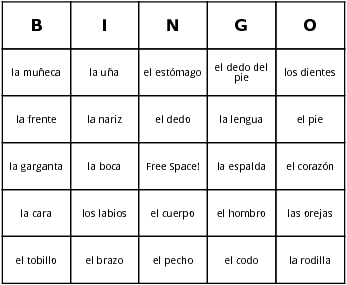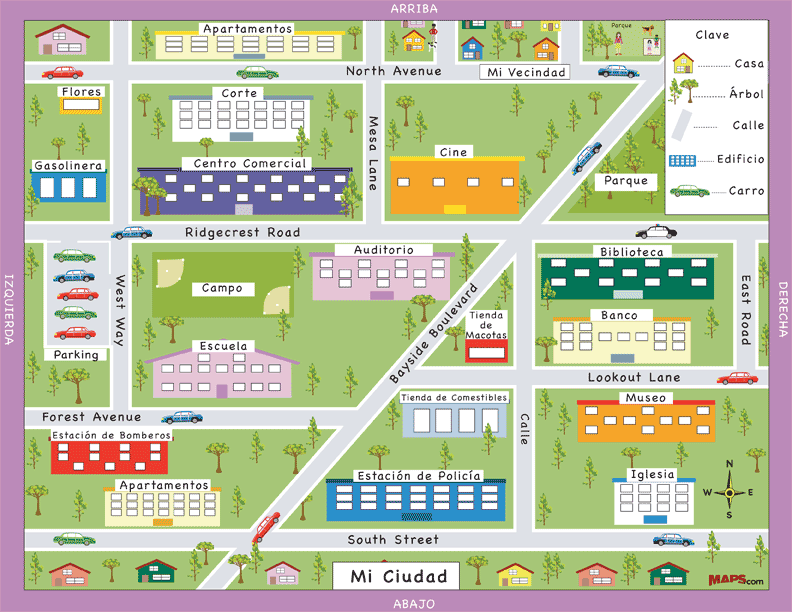Easy Learning Spanish Easy Learning Pe Games

10 Fun Spanish Classroom Games for Effortless Learning
Is there any sight better than a classroom full of smiling students?
Incorporating things your students love to do into language lessons will lead to effortless learning that may actually be—gasp—fun!
Chances are, the vast majority of them, no matter their ages, love games.
Whether their favorites are video games, board games, schoolyard games or some other sort, all students are jazzed to get in some playtime during classtime.
Contents
- The Benefits of Spanish Classroom Games
- 10 Grin-worthy Spanish Classroom Games for All Ages
-
- 1. El Juego de Correr
- 2. Bingo
- 3. ¿Qué es?
- 4. Circumlocution Game
- 5. Verb Tic-Tac-Toe
- 6. Simón Dice
- 7. Direcciones
- 8. Cucharas
- 9. Globo
- 10. Apps and Computer Games
Download: This blog post is available as a convenient and portable PDF that you can take anywhere. Click here to get a copy. (Download)
The Benefits of Spanish Classroom Games
Ever notice how the mind begins to wander and drift when it attempts to focus on boring topics?
Even if the topic itself is actually fascinating, if it isn't presented in an entertaining and engaging way, it still feels impossible to focus and get the most out of studying said topic.
Filling your lessons with practical activities that your students will actually enjoy doing will give them a positive association with Spanish class and keep them wanting to pursue their studies. Keeping everyone motivated should be one of your primary goals as a teacher.
It's extremely important to integrate a variety of activities involving listening, reading, writing and speaking practice into your lesson plans.
Games are extremely versatile and can be added to most lesson plans without a second thought. They can be used as vehicles to deliver new language concepts or as a means of reinforcing recent lessons.
With games, learning won't feel like learning: It'll feel like playtime!
10 Grin-worthy Spanish Classroom Games for All Ages
We've got a lot to cover here, but first, we'll explore games to amp up your students' Spanish vocabulary.
1. El Juego de Correr
To play this game, split your class evenly into two teams. Start counting at #1 and give a different sequential number to each member of the team. Then dole out these numbers to the other team's players as well. If there are 12 students in your class, this means that you'll now how two groups of 6 with students numbered from 1-6.
Have each team line up in a row. Next, say any English word and then a number in Spanish. For example, "apple" and "nueve."
Both students numbered "nueve" should rush to the whiteboard and write manzana as quickly as possible. The winner is then awarded a point. The game continues until one team scores the winning number of points (determined by you or your students).
2. Bingo

Not as in the farmer's dog, although you could likely incorporate that song into class if so desired as well! ThisBingo is a tried and true game that makes practicing new vocabulary engaging and interactive for students.
To play, print out blank or prepared Bingo grids for each of your students. You can fill out the grids with an assortment of vocabulary that you've been teaching lately. If the cards are blank, have the students fill in each blank on their grid with a different vocabulary word.
Afterwards, call out each of the vocabulary words. The first student to get an entire row (vertical, horizontal, or diagonal) yells out "bingo!" and wins. Once many students have a "bingo," you can continue to play for "blackout," meaning the entire board is crossed out.
For a free bingo card generator, check out print-bingo.com or osric.com.
3. ¿Qué es?
This game will get those neurons firing in your students' minds as they try to guess certain Spanish objects.
For this activity, you'll need a deck of cards with pictures of different things on them. You can do any category you like: foods, animals, colors, etc. You can then pick students one by one or ask for a volunteer to come up to the front and select a card.
Instruct the student to show the card to the rest of the class without looking at it him or herself. Then, the student will have to guess what's on the card he or she selected based on clues from the rest of the class. This should all be done 100% in Spanish, of course!
4. Circumlocution Game
Ever have a word on the tip of your tongue, but you just can't remember it? Or, do you ever want to describe something but you don't know the word for it in another language? Well, this game is useful for just those instances!
At the start of class, divide your students into pairs or groups of up to four. Next, write a broad or specific topic on the board. For example, comida or, more specifically, frutas rojas. How broad the topic is will depend on how much vocabulary your students have learnedandon how difficult you want the game to be.
Once all students have read the category, have all of the students in the group except one turn away from the board. Next, write some vocabulary words specific to the category on the board.
For the frutas rojas example, you could write manzana, fresa, tomatoand frambuesa. The one student per group who can see the board must then describe the vocabulary words without actually saying them. This will force them to venture out of their vocabulary comfort zones and get creative with adjectives!
All set for vocabulary games now? Great! Let's move on to some vivacious verb games.
5. Verb Tic-Tac-Toe
Tic-tac-toe, three in a row! Unlike the version of this game with which your students are already familiar, they'll have to do a bit more work to win the Spanish verb version.
First, have your students pair up. Next, ask each one to draw a tic-tac-toe board with various subjects in the spaces. For example, they could write "nosotros" in one square and "yo" in another.
To play, students will need some kind of reference sheet filled with Spanish verbs. You could whip one up yourself to print and distribute in class, or you could have them use the index of a verb conjugation book or choose from a deck of cards with verbs written on them. To start taking their turns, have the students choose verbs by pointing to a random one on the give sheet, book index or deck of cards.
Each round of the game should focus on a particular verb conjugation. For example, "for this round, we'll conjugate in theimperfecto." When the student is up at bat and wants to put an X or O in a certain box, they'll need to consider the verb tense you indicated, the subject in the square and the random verb that they and their partner selected. They'll then need to do the conjugation for the selected verb properly. If they don't get the conjugation right, they don't get their square.
Whoever gets three Xs or Os in a row first wins!
6. Simón Dice
Touch your head! Uh oh, Simon didn't say! You're out! Surely you've played the game Simon Says at least once in your life, and it's likely that your students have too. Simón Dice, the Spanish version of this classic game, is a perfect way for your students to practice mandatos and vocabulary simultaneously.
Ask for one student to volunteer or pick on someone to come to the front and be Simón. Simón will need to give commands to the rest of the class. Anyone who does an action that isn't preceded by "Simón dice"is out!
7. Direcciones

Just in case Simón Dice didn't provide enough mandatos fun for your students, there's always the game Direcciones! The practical applications of this game make it an optimal one to play in class.
During this activity, ask your students to partner up. Distribute maps of cities and ask your students to take turns leading each other to destinations on the maps.
The student giving the directions should have a destination in mind, but they can't share it with their partner. The partner being guided must listen carefully and make their way to the intended destination on the map. Mes-english.com has a simple option of a town map that works for this exercise, as does maps-kid.com.
8. Cucharas

Perhaps you've heard of (or have played) the card game "spoons." This is simply the Spanish twist on the game, which can be used to teach or review Spanish verbs or vocabulary.
First, make a deck of about 50 cards for each group of about six students that'll play in class. What goes on these cards? Well, that's totally up to your and your current teaching topics. Generally speaking, you'll want have 25 cards with 25 matching card. The first half might be infinitive verbs, and the second half might be conjugated versions of these verbs. Or the first half could be conjugated verbs and the second half could be subjects that match up with them. Once you've gotten your content created, print out the flashcards.
When the students can match two related cards, they can take a spoon from the center of the table (and try to do so without the other group members noticing). When other players notice that a spoon is being taken, they too may grab a spoon. Whoever gets the most spoons at the end wins!
9. Globo
This game is a little more active than the others, so get ready to move. Prior to playing Globo, you'll need to track down a sports ball such as a volleyball or a beach ball. If you'll be playing the game indoors, try to choose a ball that will cause no damage to indoor furniture. That being said, it's probably best to play Globo outside or in a gymnasium, if available.
For this game, have students take turns throwing the ball. If the ball hits a certain object (for example, the wall or a tree), then the student gets a question corresponding to a specific category. You could say that hitting the tree means the student gets a grammar question. Need ideas for questions to ask? Check out e-spanyol.hu or take exercises from the textbook or workbook you use in class.
This is a nice, easygoing game that really doesn't have winners or losers, it just gets everyone moving, active and thinking on their toes.
Another game that can touch on any topic that you cover in class is Jeopardy, which is sure to please any student. For further information on playing Jeopardy and other games, check out our previous Spanish grammar games post!
10. Apps and Computer Games
What student doesn't have a phone in their pocket these days? As technology continues to make its way into classrooms, you, too, can take advantage of the sheet volume of resources that are available to the tech-savvy teacher. This, of course, includes games that your students will love because they're fun, but also because they offer them an excuse to whip out their mobile devices in class. Win-win!
Younger students will enjoy BrainPOP's Spanish content, which has games, videos and quizzes in Spanish on a variety of topics like science, math, art and more. Students are sure to be charmed by Moby the robot and his friends, and you can easily incorporate elements from the website into a game-based lesson.
Older students who may find Moby too "childish" might instead enjoy a program like FluentU. This web- and app-based tool also lets students view videos, but these are authentic clips that native Spanish speakers would watch, like movie trailers, commercials and inspirational talks.
Since the subtitles in each video are interactive, you can make it a game with students to pick out words in videos and compile a list of vocabulary words that the class can work on together. You can then assign the flashcards (or further videos or quizzes) as homework. This way, students can feel like they're making decisions in their learning process.
But an app doesn't have to be specifically created for educators: a game like Zynga's Draw Something, for instance, is a tech take on Pictionary. While answers must be typed, you can encourage students to speak out loud, which will get students speaking in Spanish spontaneously as they try to guess what their opponents are drawing.
For even more resources on game or lesson ideas for the Spanish classroom, there are tons of sites that you can visit on the internet.
Just get exploring!
As long as you're ready and able to have some fun, games will become an effortless addition to your lesson plans.
Download: This blog post is available as a convenient and portable PDF that you can take anywhere. Click here to get a copy. (Download)
colontexprolven1979.blogspot.com
Source: https://www.fluentu.com/blog/educator-spanish/spanish-classroom-games/
0 Response to "Easy Learning Spanish Easy Learning Pe Games"
Post a Comment